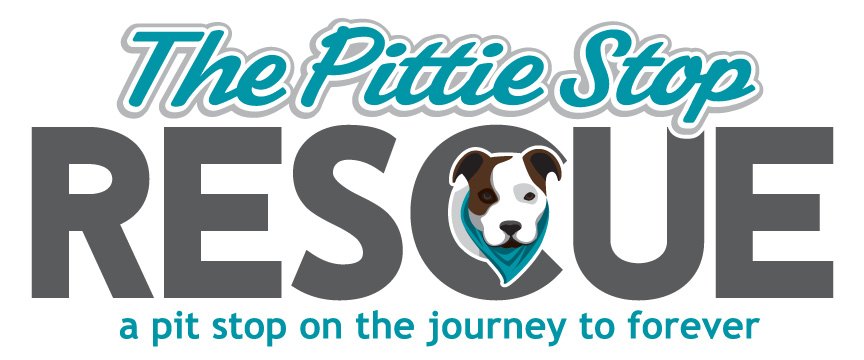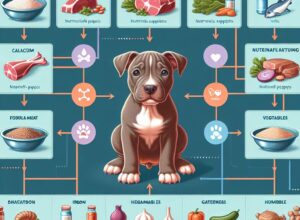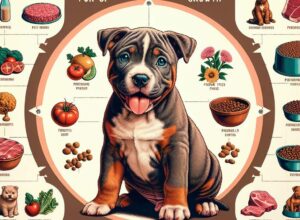
Feeding your Pitbull puppy might seem like a straightforward task, but it’s a responsibility that will significantly impact your pup’s health and happiness. As you’re about to discover, it’s not just about the quantity of food but also about the quality, timing, and adaptation to your puppy’s growing needs. Let’s dive in and set the stage for your Pitbull puppy’s optimal nutrition.
Key Takeaways
-
Young Pitbull puppies need to eat more frequently — four meals a day until they are 4 months old.
-
High-quality puppy food with proper protein and fat balance is crucial for muscle and bone development.
-
Portion sizes will change as your puppy grows; use feeding charts as a guide but adjust based on your puppy’s activity level and growth.
-
Monitor your puppy’s weight and body condition to ensure they are not over or underfed.
-
Consult with a vet if you’re unsure about your Pitbull puppy’s diet or if they show signs of food allergies or sensitivities.
Feeding Your Pitbull Puppy Right
When you bring a Pitbull puppy into your home, you’re taking on the role of their chief nutritionist. It’s your job to make sure they get the right food in the right amounts at the right times. This means understanding the specific needs of Pitbull puppies, which are known for their muscular build and energetic nature.
Essential Nutrients for Your Growing Pitbull
Pitbull puppies require a delicate balance of nutrients to thrive. Protein is the building block for their muscular growth, while fats provide energy and help with brain development. Carbohydrates offer additional energy and fiber for healthy digestion. Let’s not forget vitamins and minerals, which support a robust immune system and overall health.
Understanding Portion Sizes Through Different Stages
As your Pitbull puppy grows, their nutritional requirements will change. It’s not just about increasing food volume; it’s about adjusting the balance of nutrients to match their development stage. A common mistake is overfeeding, which can lead to obesity and health problems later in life. Conversely, underfeeding can hinder their growth and vitality.
Feeding Fundamentals
Every Pitbull puppy is unique, and while feeding charts can be helpful, they’re not one-size-fits-all. You’ll need to observe your puppy’s appetite, energy levels, and growth to tailor their diet. Remember, a lean, energetic puppy is a sign that you’re on the right track with their diet.
Identifying Your Puppy’s Unique Needs
Consider your puppy’s individual characteristics, such as their expected adult size, metabolism, and any health considerations. For example, if your puppy is a bit on the lazier side, they may not need as many calories as an extremely active one. Tailoring their diet to their lifestyle is key to preventing weight issues.
The Role of Activity Level in Nutrition
An active Pitbull puppy will naturally require more calories than a less active one. This doesn’t mean you should just pile on more food; instead, look for higher-energy puppy food formulas that cater to active breeds. These usually have a higher calorie count per cup, so you won’t need to increase the volume drastically.
Age-Specific Feeding Guidelines
As Pitbull puppies grow, their dietary needs evolve. Here’s a breakdown of what to expect at each stage:
Newborn to 4 Weeks: Mother’s Milk and Transition
In the first month, puppies should be nursing from their mother. This provides all the necessary nutrients for a strong start in life. If you’re caring for an orphaned pup or one that can’t nurse, consult your vet for a high-quality puppy milk replacer.
As they approach the 4-week mark, you can start introducing a high-quality, nutrient-rich puppy food, softened with water. This transition is crucial and should be done gradually to avoid digestive upsets.
1-3 Months: Establishing a Solid Feeding Schedule
By the time your Pitbull puppy is 1 month old, they should be eating softened puppy kibble along with nursing. By 2 months, they’ll be ready for a more regular feeding schedule. At this age, they should be eating three to four times a day. This is the time to establish a routine that will set them up for a lifetime of good eating habits.
Remember, the key to a healthy diet is not just the amount of food but the regularity and quality of meals. Ensure each meal is evenly spaced out through the day to avoid overloading their little stomachs and to provide consistent energy levels.
4-6 Months: Adjusting Portions as Your Puppy Grows
By the time your Pitbull reaches 4 to 6 months of age, they’re likely to be a bundle of energy and growing rapidly. This is the period when their feeding portions need close attention. You’ll be increasing their food allowance, but it’s vital to do so in a controlled manner. Keep an eye on their body condition and adjust portions accordingly. At this stage, three meals a day is usually appropriate.
Most importantly, ensure that the growth is steady and not rushed. Rapid growth can lead to bone and joint problems, especially in large breeds like Pitbulls. It’s better to have a slightly leaner pup than one that’s overweight, particularly during this fast growth phase.
7-12 Months: Gradual Shift to Adult Food Quantities
As your Pitbull puppy approaches their first birthday, they’ll start to look more like a young adult than a baby. This is the time to start transitioning to adult dog food, which has different nutrient ratios more suited to a mature dog’s metabolism. The switch should be gradual, mixing increasing amounts of adult food with the puppy formula over several weeks.
By the time they’re 12 months old, most Pitbulls can be fed twice a day. The portions will be larger than what they received as a small puppy, but the total daily amount of food might not be much more, as their growth rate slows down. This is also the time to be vigilant about overfeeding, as their metabolism starts to slow.
Choosing the Right Puppy Food
Not all puppy foods are created equal. When choosing food for your Pitbull puppy, look for brands that list a high-quality protein source, like chicken or beef, as the first ingredient. Avoid foods with fillers like corn and wheat, which offer less nutritional value and can sometimes lead to allergies.
Here are some quick tips for picking the best puppy food:
-
Check the label for a statement from the Association of American Feed Control Officials (AAFCO) ensuring the food is complete and balanced for growth.
-
Look for foods with a good balance of protein and fat to support your Pitbull’s muscle development and energy needs.
-
Choose a food specifically formulated for puppies, as they have different nutrient needs than adult dogs.
Comparing Protein Sources and Ingredients
The source of protein in your puppy’s food matters. Animal-based proteins contain all the essential amino acids your Pitbull needs to grow strong muscles. Foods with multiple protein sources can provide a more balanced amino acid profile.
Here’s a quick comparison to guide you:
|
Protein Source |
Benefits |
|---|---|
|
Chicken |
High in protein, widely available, and generally well-tolerated by most puppies. |
|
Beef |
Rich in iron and a good source of protein, but can be more expensive. |
|
Fish |
Provides omega-3 fatty acids, which are good for skin and coat health. |
|
Lamb |
Often used in hypoallergenic formulas for puppies with sensitivities. |
Deciphering Dog Food Labels for Optimal Health
Understanding dog food labels is crucial to ensure you’re providing the best for your Pitbull puppy. Besides protein, look for a good balance of carbohydrates, fats, vitamins, and minerals. The ingredient list should be straightforward, without a long list of unrecognizable items. Remember, the simpler the ingredient list, the better it is for your puppy’s digestion and overall health.
Monitoring Your Pitbull’s Health and Diet
A well-fed Pitbull puppy is a happy and healthy one. Watch for signs that your puppy is thriving, like a shiny coat, clear eyes, and consistent energy levels. Their stool should be firm and regular, and they should be eager but not ravenous at meal times.
Recognizing Signs of Proper Nutrition
Here’s what to look out for:
-
A glossy coat without dandruff or excessive shedding
-
Bright, alert eyes
-
Good muscle tone and body condition
-
Consistent, healthy bowel movements
-
A good level of energy and playfulness
Adjusting Diet When Needed
If you notice any changes in your puppy’s condition, it might be time to adjust their diet. For instance, if your puppy seems to be gaining too much weight, you may need to reduce their portion size slightly. If they seem underweight or lack energy, they might need more food or a diet with higher calorie content.
Remember, always consult with your vet before making significant changes to your puppy’s diet, especially if they show signs of food allergies or sensitivities.
Common Questions Around Feeding Pitbull Puppies
Feeding your Pitbull puppy can bring up a lot of questions. Here are some of the most common ones, answered to help you navigate your puppy’s nutritional journey.
When to Consult The Vet About Your Puppy’s Diet
If you’re unsure about the type or amount of food your Pitbull puppy needs, or if they’re showing signs of digestive upset, allergies, or poor growth, it’s time to consult the vet. They can provide personalized advice based on your puppy’s specific health and nutritional needs.
Can Treats and Human Food Be Part of the Diet?
Treats can be a healthy part of your Pitbull puppy’s diet, but they should not make up more than 10% of their daily caloric intake. Human food should be given sparingly and only if it’s safe for dogs. Always avoid toxic foods like chocolate, grapes, and onions.
Let’s address some frequently asked questions that you might have as a Pitbull puppy owner. This will help you navigate through the common concerns and provide the best care for your growing companion.
Frequently Asked Questions
How Many Times a Day Should I Feed My Pitbull Puppy?
When your Pitbull puppy is under four months old, they should be eating four meals a day. This supports their rapid growth and provides consistent energy. As they grow older, you can reduce this to three meals a day from four to six months of age, and then down to two meals a day after they reach six months. This gradual reduction aligns with their decreasing growth rate and helps prevent overfeeding.
What If My Pitbull Puppy Seems Hungry All the Time?
If your Pitbull puppy always seems hungry, first ensure you’re feeding them the correct portion sizes for their age and size. If they’re still hungry all the time, consider the possibility of worms or other health issues, and consult your vet. Sometimes, puppies go through growth spurts and may need a little extra food. Just be careful not to overfeed and monitor their body condition closely.
How Do I Know if My Pitbull Puppy is Overweight?
To determine if your Pitbull puppy is overweight, look for a lack of a defined waist and difficulty feeling their ribs under their skin. A healthy puppy should have a slight hourglass figure when viewed from above, and you should be able to feel their ribs but not see them. If you’re concerned about your puppy’s weight, it’s always best to seek advice from your vet.
Is It Okay to Switch Dog Food Brands for My Puppy?
Yes, you can switch dog food brands for your puppy, but it should be done gradually. Start by mixing a small amount of the new food with the old food and slowly increase the proportion over the course of a week. This helps prevent digestive issues. Make sure the new food is high-quality and appropriate for your puppy’s growth stage.
Can My Pitbull Puppy Have Allergies to Certain Foods?
Just like humans, Pitbull puppies can have allergies to certain foods. Common symptoms include itchy skin, ear infections, and gastrointestinal problems. If you suspect your puppy has a food allergy, consult your vet. They may recommend an elimination diet to identify the allergen or suggest hypoallergenic dog food.



